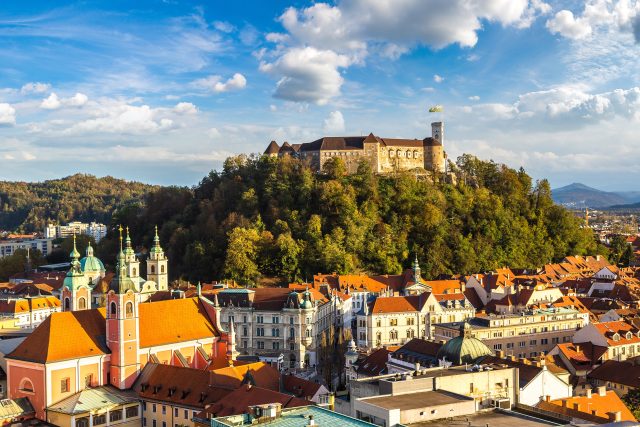
European Diary: Ljubljana, May 2022
Ljubljana, Slovenia’s capital, looks as if it comes straight out of a fairy tale, with quaint, attractive old houses in various historical styles clustering in the centre, a castle towering over it and pleasant outdoor cafés occupying the leafy banks of the river flowing through it, Ljubljanica. It was already a city in the Roman Empire, called Emona. Located on a busy trade route between the northern Adriatic Sea and the Danube region, it was the historical capital of Carniola, one of the Habsburg territories, but inhabited by Slovenes who speak a Slavic language. Its German name is Laibach. The city with its surrounding regions has long been a battleground. The Huns, the Ostrogoths, the Lombards and the Turks raided it, while Napoleon’s forces occupied it for a while. Mostly, however, the city found peace and stability for centuries under the Habsburgs, but after the collapse of the Austro-Hungarian Empire in 1918 Ljubljana became the capital of one of the provinces forming Yugoslavia, first the kingdom and then the communist state. Slovenia was the only European territory in the Second World War controlled in turn by the three kinds of totalitarians, fascists, Nazis, and communists. The post-war reprisals in Tito’s Yugoslavia were particularly harsh: it is estimated that around 130,000 people were killed by the communists. Mass graves are still being discovered in Slovenia. In 2022, Prime Minister Janez Janša designated 17 May as the National Memorial Day for the Victims of Communism.
Slovenian Independence
When I went to Ljubljana in early May 2022, my friends, Slovenian historian Dr. Andreja Valič Zver, and her husband, MEP Milan Zver, former Minister of Education, picked me up at the airport and treated me to dinner at a nice Slovenian restaurant where we had delicious local food and wine. Over dinner, we discussed the history and present circumstances of Slovenia. As Yugoslavia was collapsing in 1991, Slovenia declared her independence on 25 June. In the beginning, the Yugoslav military tried to suppress the independence movement, but after ten days of fierce fighting a truce was agreed. Subsequently, Iceland was the first Western country to recognise Slovenia’s independence on 19 December 1991, followed the same day by Germany and Sweden. My friend David Oddsson was then Prime Minister of Iceland. A staunch anti-communist, he felt great sympathy with the newly liberated nations of Central and Eastern Europe that had been under the communist yoke and now wanted to form their own nation states.
Andreja has written an accessible short book about the leader of the Slovenian independence movement, Jože Pučnik, in both Slovenian and English. The European Union (then called European Community) recognised Slovenia in January 1992 and the United States in April. In 2004, Slovenia became member of the North Atlantic Treaty Organization, NATO, and the European Union, and she also belongs to the Schengen area and the eurozone. I came to Slovenia only two weeks after parliamentary elections where a left-wing populist, the millionaire Robert Golob, had defeated the seasoned and savvy centre-right Janša, three times prime minister and a firm anti-communist, under whose leadership the country had prospered. While I was in Slovenia, Golob was forming a coalition government of his own populist movement, and the Social Democrats and the Left Party.
In Defence of Small States
In Slovenia, I was continuing a European tour promoting my recent book, Twenty-Four Conservative-Liberal Thinkers. On 10 May 2022, I gave a presentation at a seminar in Ljubljana, organised by the Faculty of Economics and Business at the Catholic Institute in Ljubljana and the Austrian Economics Center in Vienna. My main message was that paradoxically economic integration facilitates political disintegration, by which I meant the reduction in size, and the consequent addition in number, of political units in the last seventy-five years. The explanation of this paradox was, I suggested, that with economic integration small states could enjoy the immense benefits of the international division of labour. As Adam Smith remarked, the division of labour is limited by the extent of the market. I also observed that usually small states were more homogeneous than large states and that therefore the citizens often identified more with one another, developing a stronger sense of solidarity. Again, small states tended to be more flexible and transparent than the larger ones. Their citizens were closer to those who wielded power over them than was the case elsewhere. There were not necessarily any economies of scale favouring large states. Indeed, the cost per capita of policing was lower in some small states such as the five Nordic countries than in much larger states such as the United Kingdom or the United States.
Overcoming Vulnerability
The great disadvantage of small states however was their vulnerability, I conceded, recalling the famous Melian Dialogue by Thucydides. Therefore, small states had to seek strong allies. ‘Si vis pacem, para bellum,’ as the Romans used to say: If you want peace, prepare for war. I recalled that both my own country Iceland and Slovenia were members of NATO, the North Atlantic Treaty Organisation, and with good reason. The well-attended seminar was chaired by Professor Mitja Steinbacher of the Catholic Institute (one of the three famous Steinbacher brothers, all passionate economic liberals). The other speakers were American businessman Terry Anker on entrepreneurship, Austrian economist Dr. Barbara Kolm on sound money, British accountant and businessman Keith Miles on Brexit and the European Union, American writer Craig Biddle on the philosophy of individualism, and Slovenian Professor Žiga Turk, former Education Minister, on the evolutionary argument for freedom. In Ljubljana, I was interviewed by Peter Merše of the online magazine Domovina and explained to him, amongst other things, why I could include both St. Thomas Aquinas and Ayn Rand, as different as they are, in my book on Twenty-Four Conservative-Liberal Thinkers. (The short and therefore over-simplified answer is that they are both Aristotelians.)



 Subscribe
Subscribe